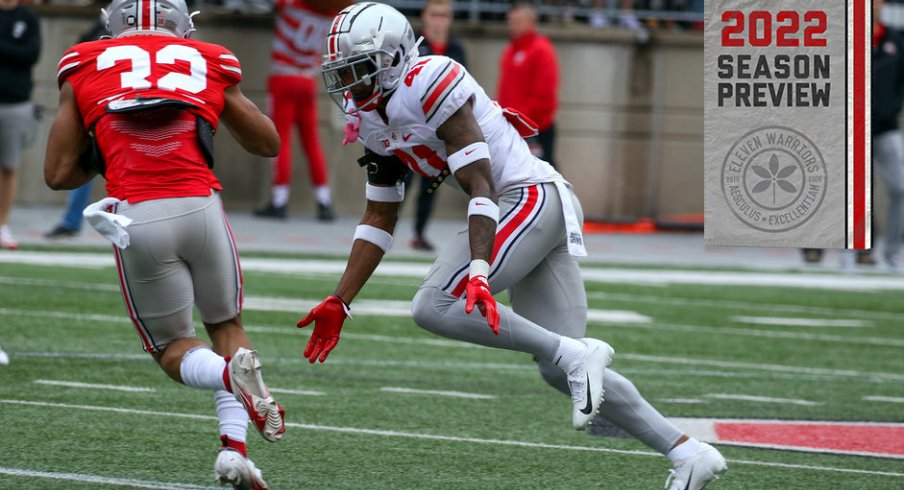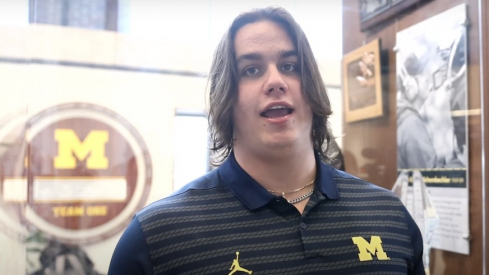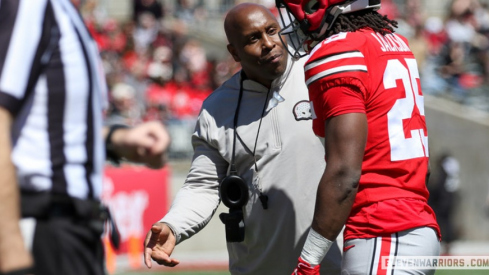By now, you know exactly who Jim Knowles is and why Columbus’ burgeoning vegan restaurant scene was not the (main) reason he moved from Stillwater, Oklahoma last winter.
Despite facing off against the best offense in the country every single day in practice, the rave reviews have already begun rolling in about his immediate impact on the Ohio State football program.
“I just think you feel a very early confident defensive bunch," offensive coordinator Kevin Wilson said after the team's first preseason scrimmage. "Long way to go, I'm sure Coach (Knowles) would tell you that. But man, out there, it's a dadgum fistfight.”
Such comments are a long way from what fans of the scarlet and gray grew accustomed to seeing over the past two seasons, as the unit led by Wilson and head coach Ryan Day seemed to carry the entire program.
“I think that our defense is presenting a lot of good challenges,” senior fullback/tight end Mitch Rossi said after the scrimmage. “They're very multiple, they disguise things well, and I think that it's really good work for us. I think that we're used to kind of getting after them, and it's good for us to have that competition up, for sure.”
How, then, has Knowles seemingly transformed a unit that welcomed just one newcomer, former Oklahoma State transfer nickelback Tanner McCalister, into a group capable of slowing down an offense with a trio of Heisman candidates in mere weeks? The answer lies in the second half of Rossi's comment, as Knowles has taken a defense previously built around one, core schematic concept and added a variety of concepts that make it harder for offenses to identify and scheme against.
Jeff Hafley became a household name in Ohio by taking a similarly underperforming defense that happened to possess a trio of NFL-ready defensive backs and perhaps the nation's best player that season in Chase Young, and putting them into positions that allowed their superior talent to shine through. Hafley effectively dared opponents to beat his defense by creating an umbrella in the secondary while Young created havoc in opposing backfields with a straightforward, single-high safety scheme on virtually every snap, mimicking the Seattle Seahawks' Legion of Boom from nearly a decade ago.
But just as Pete Carroll was forced to abandon that philosophy due to the quickly changing demands of the modern game, Knowles was brought in to update the Buckeyes' approach. Though the play-calls may look vastly different, both systems look to provide the majority of the players with straightforward responsibilities that don't vary much from snap to snap, giving them the confidence to play fast and without hesitation.
Under the previous regime, it was often the linebackers who were forced to deal with complexity, as opposing teams attacked the area just beyond the line of scrimmage via RPOs that put them in conflict. Knowing the defense would ask a second-level player to defend the same area on virtually every snap, offenses simply made them wrong by forcing them to be in two places at once while a free safety stood 30 yards from the ball in center field.
With Knowles in charge, no such confusion remains for those linebackers. While they don't simply fill the same gap on every snap, they are allowed to play run-first, taking away open lanes for a ball carrier without fear of letting a short pass sail right past them.
The reason for this newfound freedom at the linebacker spots is the pressure placed on the safeties behind them. While they certainly might drop deep and patrol center field on certain occasions, they're just as likely to come up and fill an inside run gap in Knowles' system.
Watch here as McCalister (#2) steps up to fill an interior gap as the two linebackers occupy the C-gaps outside while playing for Knowles at Oklahoma State last season.
Though McCalister will line up over the slot receiver on most snaps, Knowles thinks of the position like his two other safeties. All three players must be adaptable and display a variety of skills against both the run and the pass.
“When you adjust to the college game and how spread (offenses are) and all the speed that’s on the field, you need to be multiple in your disguises, looks, coverages, where safeties fit in the run game,” Knowles told reporters recently. “And in order to do that, you need a bunch of fast, athletic guys out there who are also willing to hit and be physical. That’s why I think the development of the safety position within the scheme is so critical.”
Buckeye fans may be surprised to see how much physicality will be expected of the safeties with Knowles calling plays. No longer will the likes of Ronnie Hickman and Josh Proctor only make tackles 10 yards downfield, as they'll be tasked with bringing down runners quickly, and with a presence.
For example, we can see Cowboy free safety Jason Taylor II (#25) shed the crack block from an opposing slot receiver and fill the B-gap to bring down the runner for no gain last season.
These aren't safeties looking to back peddle as soon as the ball is snapped. Rather, they're expected to get downhill and stick their noses in the middle of things. Luckily, in addition to McCalister, who followed Knowles up north, the Buckeyes have a duo ready to take on these challenges.
With McCalister lining up on the wide side of the field where most offenses send their slot receivers, Josh Proctor will play the opposite Bandit (Boundary) spot, most often replacing the third linebacker that is no longer there in Knowles 4-2-5 lineup.
“He's rangy. He can cover a lot of ground. He's extremely physical," Day said of Proctor back in the spring as he was still recovering from the broken leg which caused him to miss the majority of the 2021 campaign. "I mean, he will absolutely get after you, whether it's receivers downfield or coming up and playing the run game blitzing. He'll come downhill and he'll play physical. And he also has really good ball skills."
Having played the deep safety position in 2020 following Jordan Fuller's departure, this will be a change for the fifth-year senior. Luckily, he seems excited to show he's capable of making plays near the line of scrimmage.
“It jacks me up a lot,” Proctor said of Knowles’ defensive philosophy. “Because I know, just being back there, sometimes you can just be running around, sideline to sideline, not really get a lot of action. But knowing that it’s really a safety-driven defense, and you’re reading all these different keys, you’re always in the play. You’re never just going to be back there bored and just sitting there looking.”
While the first-teamers weren't tackling at full speed during the spring game back in April, we could still see how Proctor's role had changed when it came to stopping the run. With the defense employing man coverage across the board (Cover 1) in the clip below, the senior safety was matched up with the tight end who came across the formation to block a split-zone run concept, and Proctor was in a great position to bring down one of the nation's best runners in TreVeyon Henderson.
Some fans will assuredly love seeing the hard-hitting safety hang out around the line of scrimmage in an effort to improve a run defense that underperformed a year ago, but this aggressive approach can come at a cost. Though Knowles' Cowboys finished fifth in total defense a year ago by employing this philosophy, they weren't invincible.
Knowles' Oklahoma State safeties could get caught playing too downhill on occasion, allowing offenses to make plays over the top. For instance, their arch-rivals caught the boundary safety cheating toward the backfield on a play-action pass with the tight end streaking past him downfield.
Such busted plays didn't happen all too often, but more than most Buckeye fans might expect. Despite doing an excellent job of keeping opponents from accruing excessive yardage and scoring points overall, the Cowboys ranked just 60th nationally in allowing gains of 20 yards or more, a full ten spots behind the beleaguered Buckeye defense last fall.
Perhaps more than anything, this stylistic difference may be anathema to the masses in Central Ohio. The aforementioned 2019 OSU defense finished first nationally by consistently holding opponents in check on first and second downs, forcing them to convert 3rd & long with Young chasing quarterbacks around the pocket while Jeff Okudah and Damon Arnette blanketed their top targets.
| Defense | On 1st Down | On 2nd Down | On 3rd Down |
|---|---|---|---|
| 2019 Ohio State | 16.5% | 19.4% | 29.1% |
| 2021 Ohio State | 21.4% | 32.0% | 42.1% |
| 2022 Oklahoma State | 28.3% | 39.7% | 28.6% |
Knowles' Cowboy defense found success in a very different manner, however. His troops were more likely to let their opponents move the chains on first and second downs than Ohio State did last fall. On third downs, however, the story was far different, as the orange and black OSU was even more effective at getting off the field than even the more talented 2019 Buckeyes.
To do this, Knowles kept opposing offenses in check by mixing up his coverages, which was only achievable thanks to the tremendous amount of pressure placed on his safeties. With the cornerbacks tasked with manning up the outside receivers in some variety most of the time, the three safety positions had to change their shape and responsibilities in order to confuse quarterbacks.
In Columbus, much of that responsibility will fall on the third safety, Ronnie Hickman, to cover up the sins of everyone else, hence the name of his position, the adjuster.
“The safety position definitely has to make a lot of calls, you got to be vocal, you kind of got to be that quarterback on the defense,” Hickman said in the spring. “Being able to read the quarterback, make plays on the ball and then fill the alley when I need to, to covering space, whether it's covering tight ends and stuff like that. All those things I feel like a safety needs to be able to do, and I feel like I'm equipped for that.”
Seemingly swapping roles with Proctor after playing as a hybrid linebacker/safety and leading the team in tackles one year ago, Hickman quickly impressed his new coach.
“I love Ronnie Hickman. I think he's got the skill. I think he's got the savvy. I just think he's a great piece in the middle there to run the show back there,” Knowles said in the spring. “I just like the way he plays and handles his business.”
Despite what he says to the media, Knowles' true real vote of confidence will come on the field, tasking Hickman and his compatriots with running a variety of coverage options on third downs. One of the most complex and effective coverages upon which he relies is the version of Quarters also favored by the likes of Nick Saban and his acolytes in passing situations, known by many as Cover 7.
OSU fans may recall seeing Quarters coverage on early downs while Chris Ash was running the defense last decade, and on occasion, last fall after Matt Barnes took over the unit from Kerry Coombs. But this iteration is not only more focused on stopping the pass, but it's also more of a philosophy than a single play-call, comprising dozens of checks and variations that allow the defense to be in the perfect position to stop whatever pass concept may be in the scouting report.
The name of the concept comes from dedicating seven defenders who all work together to cover the five eligible receivers, splitting the field in half and working in groups. The defenders will pattern-match, meaning they may start in what looks like a traditional man-to-man technique, but will trade responsibilities if the receivers cross.
Corners will often stay locked up on their initial assignments outside, meaning the heaviest burden falls on the safeties and linebackers to handle all the interior routes. While that can often mean covering a tight end or running back, it also means sometimes running one-on-one downfield with a dangerous slot receiver like Jaxon Smith-Njigba, as Proctor was forced to do in the OSU spring game (watch the bottom half of the screen).
The goal of the concept is to force the quarterback to check down to his last option, which often won't get the job done on third down. But it's famously not the only option in Knowles' toolbox, as he is just as likely to blitz six defenders and leave the secondary in one-on-one matchups with zero help.
His goal, of course, is to sew confusion among not only the opposing QB but also his play-caller on the opposite sideline.
“We want to be able to create indecision for the offense, and particularly for the offensive coordinator. I think in college, offensive coordinators even have more hand on things that happen than in the NFL, so we want to be able to create multiple defenses out of simple looks and to be creative in a way that the players can understand,” Knowles said at his introductory press conference in February. “So we want to create two to three simple pictures, that when you look at it, or the offensive coordinator looks at it, he can't tell what's going to happen from that same picture. And that we have the ability to really do anything out of that same picture or that look.”
All of those different looks are only possible because his safeties shoulder the burden of lining up all over the field while still being just as capable of bringing down a runner in the backfield as they are covering a receiver 20 yards downfield, often trading roles from snap to snap. If Knowles is successful in returning the Ohio State defense to its traditional place among the sport's elite, Proctor, Hickman, and McCalister must meet their coach's challenge and become elite players themselves.
“We talk about having a Silver Bullet defense to mirror the traditions that have been around here, I tell the guys that means top five," Knowles responded when asked about Day's expectation of producing a top ten defense nationally. "That's what we're pressing for. But nothing really goes through my mind other than it's great to be at the Ohio State because the expectations are high. And that's what I've always wanted.”



